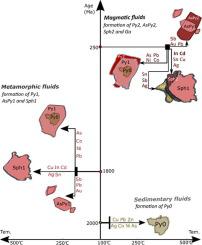当前位置:
X-MOL 学术
›
Ore Geol. Rev.
›
论文详情
Our official English website, www.x-mol.net, welcomes your
feedback! (Note: you will need to create a separate account there.)
Tracing mineralization history from the compositional textures of sulfide association: a case study of the Zhenzigou stratiform Zn-Pb deposit, NE China
Ore Geology Reviews ( IF 3.2 ) Pub Date : 2020-11-01 , DOI: 10.1016/j.oregeorev.2020.103792 Lingli Zhou , Qingdong Zeng , Jianming Liu , Xiaoxia Duan , Guotao Sun , Yongbing Wang , Peiwen Chen
Ore Geology Reviews ( IF 3.2 ) Pub Date : 2020-11-01 , DOI: 10.1016/j.oregeorev.2020.103792 Lingli Zhou , Qingdong Zeng , Jianming Liu , Xiaoxia Duan , Guotao Sun , Yongbing Wang , Peiwen Chen

|
Abstract The Qingchengzi Orefield located in northeastern China hosts more than ten Pb-Zn deposits and several Au-Ag deposits. Among those, the Zhenzigou Zn-Pb deposit displays a typical stratiform morphology, comprising ore bodies in layers and lenses. The ore minerals are simply composed of sphalerite, galena, pyrite, and pyrrhotite, together with minor arsenopyrite, marcasite, and argentite. A sulfide association of sphalerite-galena-pyrite-arsenopyrite was selected for this study; the interior compositional texture of the sulfide association was investigated by means of LA-ICPMS spot and mapping analysis, with the aim of constraining the ore genesis, fluid evolution history and element partitioning behavior. The results show that three distinct fluids were involved in the mineralization, namely an episode of sedimentary fluids at ∼2052 Ma which is responsible for the precipitation of pyrite core (Py0), an episode of metamorphic fluids at ∼1800 Ma which formed an overgrowth of pyrite (Py 1) and new crystallization of sphalerite (Sph1) and arsenopyrite (Aspy1), and a final episode of hydrothermal fluids related to the Triassic magmatism, forming another overgrowth of pyrite (Py2), sphalerite (Sph2) and arsenopyrite (Aspy2), together with minor precipitation of galena (Ga). The sedimentary fluids are relatively low in temperature ( 300 °C) and have remobilized As, Co and Ni but only at mineral grain scale. The late metamorphic and magmatic fluids are enriched in In, Cd, Au, As, Ag, Cu, Pb, Sb, Sn, Co and Ni, and depleted in Bi, W, Mo, Te, and Se. The partitioning of most of the metals from the fluids into the sulfide minerals was controlled by the metals’ availability in the fluids and by the compatibility with crystal structure through direct or coupled substitutions. Pyrite acts as the main host of Co, Ni, Pb, and As; arsenopyrite hosts a major amount of Sb and Pb, and a minor amount of Au; sphalerite is the primary host of Cd, In, Cu, and the secondary host of Ag and Sn; galena is the primary host of Ag, Sb, Sn, and subordinately hosts Cd, In and As. In particular, a remarkable amount of In and Cd was carried by the hydrothermal fluids associated with the Triassic magmatism, indicating that the contribution of magmatic hydrothermal fluids to the mineralization is significant. In conclusion, our in-situ geochemical evidence of sulfide minerals reinforces a sedimentation-metamorphism-magmatic-hydrothermal reworking model for the Zhenzigou stratiform Zn-Pb mineralization. This case study underlines the significance of compositional textures of coexisting sulfide minerals when assessing the ore genesis. Overall, our study demonstrates that, by integrating trace element mapping and spot analysis on coexisting sulfide minerals, it is possible to re-construct the fluid evolution history, resolve the metal behaviors associated with fluids evolution, and review the contribution of individual fluids to mineralization.
更新日期:2020-11-01











































 京公网安备 11010802027423号
京公网安备 11010802027423号